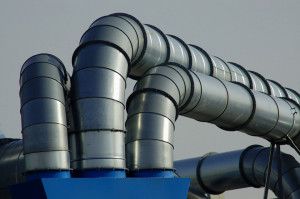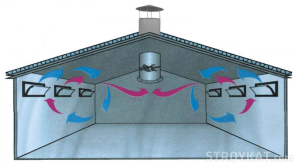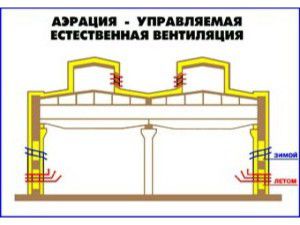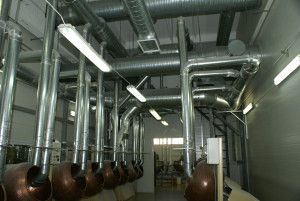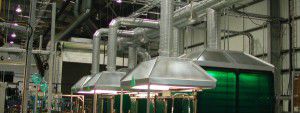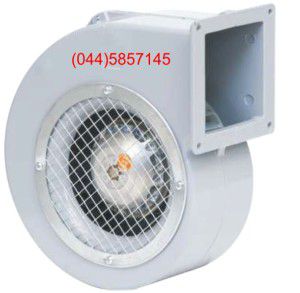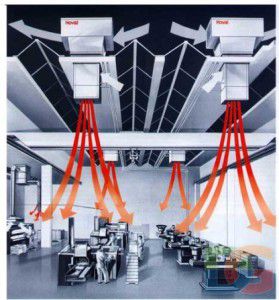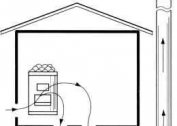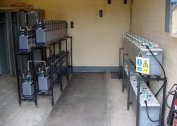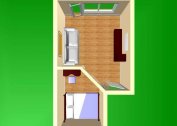The fundamental difference between industrial ventilation is that the equipment copes with the maintenance of large rooms, often with very difficult microclimate conditions. Harmful substances, hot steam or dust can be released into the air. The main task of exhaust ventilation of industrial premises is to quickly "catch" all undesirable impurities and remove them without harming the environment.
Types of ventilation
According to the method of air movement, there are two types of ventilation:
- mechanical;
- natural.
According to the principle of operation, all ventilation units are divided into:
- Supply (for supplying fresh air), can be local (an oasis, a curtain or an air shower), as well as general (an inflow directed or dispersed).
- Exhaust (evacuated exhaust air), are common or local.
Natural ventilation in industrial buildings
Any natural supply or exhaust ventilation of the production room operates using the difference in temperature and air pressure in the workshop and on the street. So, the driving force of natural traction are wind and thermal pressure.
Due to the temperature difference, expanded warm air masses are forced out of the workshop, and clean, cold ones are pulled in their place. An area of high pressure is formed from the windward region, which increases the flow of fresh air from the outside. On the leeward side of the building, pressure on the contrary is always lowered, which contributes to the outflow of exhaust air. Physical laws have been successfully applied to ventilate enterprises with intense heat generation. But not in all cases, a powerful exchange of air guarantees the creation of all necessary conditions for the work of personnel.
The more noticeable is the temperature difference near the floor and the ceiling of the workshop, as well as the higher the room, the more efficient the system will work.
If there are gaps in the walls and windows of the workshop, doors or gates often open, drafts and a drop in temperature are likely to occur. In the summer, in areas remote from doors and windows, the ventilation standards of industrial premises are violated.
Indoor air aeration
Aeration in some cases creates efficient air exchange based on natural draft. For its implementation, aeration lamps are installed - specially designed ventilation elements.
Sometimes, during the construction of a production building, ventilation is not calculated, equipment is not mounted. Then it is possible to place mines and channels working due to heat pressure in the finished shop. The mine exits are covered with head-baffles. The wind blows around the deflector and forms a rarefaction area in the pipe, increasing air inflow. A similar system is widely used in agricultural and livestock buildings, forges, small bakeries. The pipe is installed on the highest ledge of the roof.
Aeration is one of the most effective examples of natural industrial ventilation. It is used in industries with abundant formation of gases, poisons and heat.
Natural ventilation device in the workplace
Served buildings are equipped with 3 levels of openings with special design air vents. The first two rows of openings are located at a height of 1-4 meters from the floor. In the roof, light-aeration lamps with adjustable window panes are installed.
In summer, clean air flows through the lower transoms, while dirty air flows up. In the cold season, air penetrates through the middle row of vents and, warming up, reaches the level of personnel.
The different position of the vents controls the intensity of ventilation. Calculating the ventilation of the production room, determine the area of window leaves, openings. Since the worst time for the system to work is warm, calm weather, they take it as a reference point.
In windy weather, natural traction works better. But with a combination of a certain force and wind direction, reverse thrust can be created.
Mixed with dust and gases, clean air is sent to areas where people are located. To prevent the spread of dust and dirt, install flashlights with a non-blowing structure with protection from the wind.
In the hot season, the supply air is cooled by spraying cold water in it from nozzles located in the window region. The air cools and the humidity rises slightly.
For buildings with natural aeration, there are some requirements:
- its perimeter should be open to air;
- one-story workshops or high-rise buildings located on the last floors are aerated.
It is very difficult to mount natural ventilation in multi-span industrial premises. With the width of the workshop more than 100 meters, the delivery of clean air to the center of the building is practically impossible. Then for aeration install Baturin's non-inflated lights with a separate channel for exhaust and inflow. In winter, such a system can cause an undesirable drop in temperature in the working area of the production room. Therefore, in multi-span workshops, forced ventilation is usually installed with heating of the inflow.
All aeration elements are controlled mechanically.
The advantage of this type of ventilation of industrial premises is the ability to provide powerful air exchange.
Another plus in the low cost of mechanisms.
Disadvantages:
- weather dependence;
- management complexity;
- the inability to provide remote jobs with fresh air.
Aeration, as a type of ventilation of industrial premises, is unacceptable if the technology involves the spread of harmful impurities, dust. Because the filtration of exhaust air masses is impossible.
Forced ventilation in industrial premises
Supply or exhaust ventilation schemes for industrial premises with mechanical traction make it possible to bring the parameters of the air supplied to the room to the required ones (moisten, filter, cool, heat and neutralize the air).
Benefits of forced ventilation:
- her work is not related to the temperature outside;
- it is possible to supply, remove air from the necessary point;
- it is possible to change the ventilation rate of the production room within any limits;
- it is possible to make an accurate calculation of exhaust or supply ventilation of a production room.
Among the types of ventilation of industrial premises used today, forced exhaust is the most widespread.
Ventilation of industrial premises limits the spread of dirty air and takes it directly from the source of occurrence.
The quality of the local ventilation of the production room is affected by the correct selection of equipment, the shape of the air inlets, and the degree of discharge of the atmosphere.
All types of exhaust systems for ventilation of industrial premises consist of such components as:
- suction (air intake);
- fan;
- air ducts;
- Filters
- exhaust duct.
The entire volume of dirty air must be captured by the air intake and then transferred through the local ventilation system of the production room.
Types of production air intakes
There are two types of suction or air inlets for ventilation systems:
- closed;
- open.
Open type air inlets consist of:
- protective cover;
- exhaust hood;
- airborne or articulated telescopic suction (installed directly at the workplace);
- movable air intakes.
Such receivers are distinguished by the fact that the aperture for the entry of dirty air is a little further from the place of its discharge.
The protective dust cover eliminates the dust column (the so-called dust torch), which is formed, for example, in the carpentry industry: during grinding, polishing, on grinding machines. The device contains a visor and is installed across the movement of dust particles.
The multiplicity of local ventilation of the production room is calculated based on the speed and diameter of the grinding or grinding wheel.
Exhaust hoods reduce the area of distribution and remove hot air containing hazardous impurities and rising up according to the convection principle. The size of the umbrella should completely cover the area of the hot air source. Umbrellas are made with or without overhangs. Overhangs are made of rigid sheets or dense canvas. Open umbrellas are more convenient as overhangs do not interfere with staff access.
In hazardous industries, the flow rate of air entering the umbrella should be from 0.5 meters per second and higher. If the umbrella removes hot air without impurities, the speed should be from 0.15 to 0.25 meters per second.
On pickling and galvanic baths, air inlets in the form of gaps or airborne suction are installed. Air moves over the bathtub and draws out the harmful fumes of alkalis and acids until they spread throughout the room.
If the width of the bathroom is small (up to 70 cm), single-sided suction is installed.
Wide baths are equipped with double-breasted suction, as well as with structures that blow off vapor from the surface of the liquid, “with a blower”.
The volume of air passed through such devices depends on the surface area of the liquid, the degree of toxicity of the vapor, and the temperature of the liquid. Since fumes quickly destroy metal structures, ventilation of industrial premises in this area is made of resistant materials, such as PVC.
In welding and soldering workshops, the suction is installed on vertical or beveled panels with many holes.
Telescopic and articulated suction are very common. Thanks to the retractable pipe, the suction end can be brought closer to the desired location.
In workshops with semi-automatic welders and carbon dioxide soldering irons, suction pumps are mounted directly in tools. Such equipment is effective for air exchange up to 20 cubic meters per hour.
If the place of work of the welder is not fixed, mobile suction is used, some of them are attached to the welder on suction cups.
Closed-type suction pumps:
- fume hoods;
- cabins;
- shelter boxes;
- cameras.
Fume hoods are installed in workshops with abundant release of toxic fumes and gases.
Shelter boxes do not provide open apertures and are used in factories with radioactive and highly toxic substances. The worker performs all manipulations by means of rubber gloves and built-in sleeves or mechanical devices.
Local exhaust ventilation in industrial premises with complete isolation of sources of hazardous emissions is called aspiration and is considered one of the safest and most effective schemes.
Types of production fans
The air in forced ventilation systems is driven by mechanical devices: blowers powered by electricity. Most often, radial or axial models are installed.
A radial or centrifugal fan is also called a “snail” in the form of a housing in which a wheel with blades is built-in. During the torsion of the wheel, air enters the housing, changes direction and is supplied under pressure to the duct.
Exhaust air is often saturated with harmful and aggressive components and even explosives. Depending on the possible impurities, fans are used:
- standard view for air temperatures up to +80 degrees with a small amount of dust;
- anticorrosive type - for alkali and acid fumes;
- with spark protection - for explosive air mixtures;
- Dust - used if dust in the air is more than 100 milligrams per cubic meter.
Fan numbers indicate wheel diameter in decimeters.
Axial fans are inclined blades mounted in a cylindrical housing. During operation, air moves parallel to the fan axis. Such models are installed more often in medium-sized networks, emergency exhaust ducts and in mines. Their advantage is that one fan can supply air in two opposite directions, carrying out both exhaust and intake.
Air is supplied to the necessary points through the air ducts. Most often they are made of sheet metal, and when working with aggressive substances - from plastic, ceramics and other stable materials.
Dust collectors and filters for industrial use
The quality of air emissions into the atmosphere is regulated by the requirements for ventilation of industrial premises. Therefore, dirty air from industrial plants must be filtered before being discharged into the environment. One of the most important parameters calculated for ventilation of a production room is the efficiency of air cleaning.
It is calculated as follows:
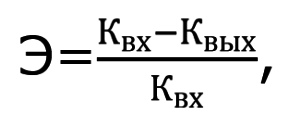
Where KvhIs the concentration of impurities in the air before the filter, Quh- concentration after the filter.
Sometimes a single dust collector or filter sufficiently purifies the air, then cleaning is called single-stage. If the air is very polluted, it is necessary to organize multi-stage cleaning.
The type of cleaning system depends on the amount of impurities, chemical composition and form.
The simplest design of dust collectors is dust settling chambers. In them, the air flow rate decreases sharply and due to this, mechanical impurities settle. This type of cleaning is suitable only for initial cleaning and is not very effective.
Dust chambers are:
- simple;
- labyrinthine;
- with a chipper.
To capture dust with particles greater than 10 microns, cyclones are used - inertial dust traps.
Cyclone - This is a cylindrical container made of metal, tapering from the bottom. Air is supplied from above, dust particles under the influence of centrifugal forces hit the walls and fall down. Clean air is discharged through a special pipe.
Two small cyclones installed one after the other increase the cleaning efficiency by 90% compared to one large one.
To further increase the amount of trapped dust, water is sprayed into the cyclone body. Such devices are called cyclone washers. Dust is washed off with water and sent to sedimentation tanks.
The modern type of dust collectors is rotary or rotoclones. Their work is based on a combination of Coriolis forces and centrifugal forces. The design of rotoclones resembles a centrifugal fan.
Electrostatic precipitators - This is another way to clean the air of dust. Positively charged dust particles are attracted to electrodes with a negative charge. High voltage is passed through the filter. To clean the electrodes of dust, they are automatically shaken from time to time. Dust enters the drives.
Gravel and coke filters wetted with water are also used.
Medium and fine filters are made of filter material: felt, synthetic non-woven materials, fine nets, porous fabrics.They capture the smallest particles of oil, dust, but quickly get clogged and require replacement or cleaning.
If air needs to be cleaned of very aggressive, explosive substances or gases, ejection systems are used.
The ejector consists of four chambers: discharge, confuser, neck, diffuser. Air gets into them under high pressure, carried away by a powerful fan or compressor. In the diffuser, dynamic pressure is converted to static, after which the air mass is carried away.
Supply ventilation in the workplace
The ventilation standards for industrial premises are specified in SNiP 41-01-2003. Before serving, the air should be treated: cool or warm, filter off dust, and sometimes increase its humidity.
Supply ventilation device:
- air intake
- air ducts;
- Filters
- heaters;
- fan;
- air distributors.
When mounting the ventilation of the production room to accommodate the heater, filter and fan, an inlet chamber is organized.
Air inlets are located at a height of 2 m above ground level, in places remote from sources of pollution, sometimes above the roof of a building. When selecting a place, the direction of the winds is taken into account. Outside, air intakes cover blinds, grilles or umbrellas.
Supply air is cleaned by filters of various types, most often from nonwoven materials.
The air in the winter is heated by shadows or heaters. The coolant is water or electricity. If necessary, humidification chambers are installed, where a finely dispersed fraction of air is sprayed. Air is cooled in the same way.
Local supply air system
Ventilation requirements for industrial premises are not always met by general ventilation. And then the local supply system is installed.
Types of local ventilation:
- air-curtains;
- air showers;
- oases;
- air curtains.
Air shower it is a stream of clean air directed to the workplace. Its purpose is to enhance the heat transfer of the employee’s body and prevent overheating.
Shower units can be:
- stationary;
- mobile.
Showering is organized in hot shops, as well as with infrared irradiation of personnel of more than 350 W / sq. meter.
The ventilation rates of industrial premises of this type depend on the severity of work, the air temperature in the workshop and the intensity of infrared radiation. On average, the air temperature in the air shower is from +18 to +24 degrees. The flow moves at a speed of 0.5 to 3.5 meters per second. Speed is directly proportional to air temperature and radiation intensity. And the temperature of the supply stream is inversely proportional to these indicators.
To change the direction of the air flow, special rotating nozzles are attached to the ends of the air ducts.
Air oases serve a whole section of the workshop, which is fenced off from the rest of the area with light screens. At the site, the air moves with the calculated speed and temperature. In an oasis, the ventilation rate of an industrial building is carefully calculated.
Air-thermal and air curtains are designed to prevent overcooling of employees and cooling the premises through open doors or openings.
There are 2 types of curtains:
- heated air supply;
- without heating.
General ventilation is necessary in cases where moisture, heat and pollution enter the entire volume of the workshop and, using local measures, ventilation standards for industrial premises cannot be observed. With a general ventilation system, the exhaust air in the production room is diluted clean to the requirements of sanitary control. This is not an economical or not very efficient system.
To prevent leakage of dirty air from the workshop, ventilation chambers and ducts are carefully sealed and the ventilation of the production room in the cleanest places is mounted.
According to the norms of sanitary-hygienic control of ventilation systems of industrial premises, all components are kept clean and undergo periodic inspections.
Air is supplied at a speed of up to 15 meters per second through slotted ducts, creating an obstacle to the flow of cold street air. Read more about thermal curtains in the video:
